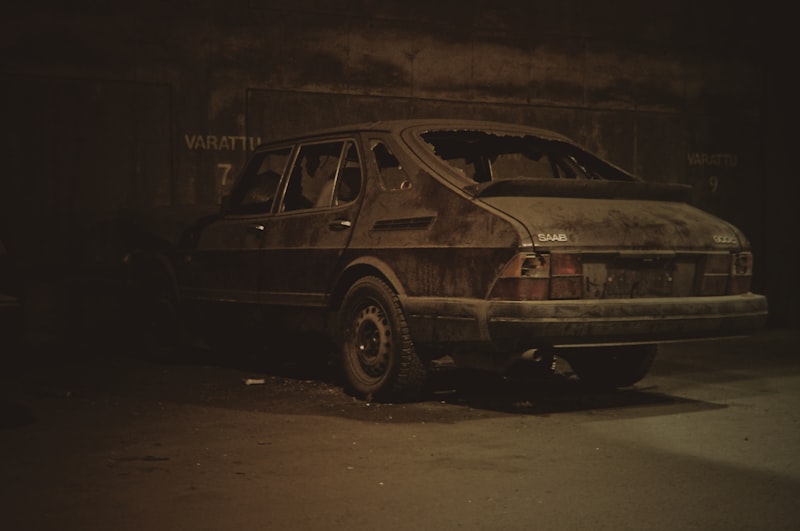Firstly, assess the extent of the rust damage. Minor surface rust can sometimes be treated with a simple sanding and painting process. However, if the rust has penetrated deeper into the metal, more extensive repairs may be needed.
Start by cleaning the affected area thoroughly. Use a wire brush or sandpaper to remove all traces of rust, dirt, and old paint. This step is crucial as it ensures that the repair materials adhere properly to the metal surface.
Once cleaned, apply a rust converter or neutralizer to the area. These products chemically react with rust, turning it into a stable compound that can be painted over. Follow the manufacturer’s instructions carefully when applying the converter.
After treating the rust, it’s time to repair any damaged metal. For small holes or deep pits, use a body filler designed for automotive use. Apply the filler smoothly over the affected area, ensuring it’s level with the surrounding surface. Allow it to dry completely before sanding it down to a smooth finish.
Next, prime the repaired area to prevent future rusting. Automotive primer creates a barrier between the metal and the environment, ensuring long-lasting protection. Choose a primer suitable for use with automotive paints.
Finally, repaint the repaired area to match the rest of your vehicle. Use automotive paint that matches your car’s color and apply it in thin, even coats. Allow each coat to dry completely before applying the next one.
By following these steps, you can effectively repair rust damage on your vehicle and prevent it from spreading. Regular maintenance and addressing rust issues promptly can help extend the life of your car’s bodywork, keeping it looking great for years to come.
Revive Your Ride: Expert Tips for Repairing Rust Damage on Your Vehicle
First off, assess the damage. Rust can hide in tricky spots like undercarriages, wheel wells, and around the edges of doors. Look for bubbling paint or reddish-brown patches – these are telltale signs that rust has set in.
Once you’ve located the rust, it’s time to prepare the surface. Grab some safety gear – gloves, goggles, and a mask – because you’ll be dealing with chemicals. Use a wire brush or sandpaper to remove the rust down to bare metal. This step is crucial to ensure that the repair will hold up over time.

After cleaning the area, apply a rust converter. This magical solution halts the rusting process by chemically converting iron oxide (rust) into a stable compound. Follow the product instructions carefully – usually, you’ll need to apply it with a brush or a spray.
Next up, it’s time to fill and smooth. If there are pits or holes left after removing the rust, use a body filler to even out the surface. Apply it in thin layers, letting each one dry before sanding it smooth. This process may take a few rounds to get it just right.
Once the filler is dry and smooth, sand the area again to blend it seamlessly with the rest of your car’s body. Start with a coarse grit sandpaper and finish with a finer grit for a polished look.
Now comes the fun part – painting! Choose a high-quality automotive primer and paint that matches your car’s color. Apply several thin coats, allowing each one to dry completely before adding the next. This ensures a professional finish that will protect your car from future rust.

Finally, apply a clear coat to seal the paint and protect it from the elements. This extra layer will keep your paint looking fresh and shiny for years to come.
With these expert tips, you can revive your ride and say goodbye to rust damage. Remember, taking care of your car now will save you time and money in the long run. Happy repairing!
Battle of the Rust: Techniques to Restore Your Car’s Shine
Firstly, tackling rust requires thorough preparation. Start by washing your car thoroughly to remove dirt and grime. This step ensures that you have a clean surface to work on. Next, inspect the affected areas closely. Rust tends to hide in crevices and under paint chips, so a detailed examination is crucial to identify all problem spots.
Once identified, the next step is to remove the rust. This can be done using various techniques such as sanding, grinding, or chemical treatments. Sanding is effective for surface rust, while grinding may be necessary for deeper corrosion. Chemical rust removers are also available and can be applied to dissolve rust without damaging the underlying metal.
After removing the rust, the affected area needs to be primed to prevent future corrosion. Apply a rust-inhibiting primer to seal the metal and create a smooth surface for painting. Choose a high-quality automotive primer suitable for the type of metal you’re working with.
Now comes the crucial step of painting your car. Select a paint that matches your vehicle’s original color and quality. Apply several thin coats of paint, allowing each coat to dry completely before applying the next. This ensures a smooth and even finish.
Finally, finish off with a clear coat to protect the paint and give your car that glossy shine. The clear coat acts as a barrier against UV rays and environmental contaminants, keeping your car looking vibrant for years to come.
Restoring your car’s shine after battling rust is a labor of love, but the results are well worth the effort. With these techniques, you can revive your vehicle’s appearance and ensure it turns heads wherever you go. So roll up your sleeves, grab your tools, and let’s restore that showroom shine together!
DIY Guide: Step-by-Step Rust Repair Methods Every Car Owner Should Know
Rust can be a persistent issue for car owners, but tackling it yourself can save both money and time. Understanding the step-by-step methods for rust repair is essential for maintaining your vehicle’s appearance and structural integrity.
Firstly, assess the extent of the rust damage. Minor surface rust might only require sanding and repainting, while deeper rust might involve cutting out the affected area and welding in new metal.
Next, gather your tools and materials. You’ll typically need sandpaper or a wire brush for cleaning, rust converter or primer, automotive paint matching your car’s color, and protective gear such as gloves and goggles.
Start by cleaning the rusted area thoroughly with the sandpaper or wire brush. This removes loose rust and prepares the surface for treatment.
Apply a rust converter if the rust is extensive. This chemical treatment converts iron oxide (rust) into a stable compound, preventing further corrosion.
After treating the rust, apply primer to the affected area. Primer ensures a smooth surface for the paint and improves adhesion.
Once the primer is dry, apply automotive paint that matches your car’s color. Apply multiple thin layers, allowing each layer to dry completely before applying the next.
Finish with a clear coat to protect the paint and give a glossy finish. This step enhances durability and weather resistance.
Regularly inspect your car for signs of rust, especially in vulnerable areas like wheel wells and the bottom of doors. Early detection and prompt repair can prevent costly damage and maintain your car’s value.
Saving Your Steel: Effective Ways to Fix Rust Damage Without Breaking the Bank
Firstly, prevention is key. Regularly inspect your steel items, such as tools, furniture, or outdoor fixtures, for any signs of rust. Addressing early spots of rust with immediate action can prevent extensive damage later on.
For minor rust spots, a DIY approach can work wonders. Start by scrubbing the affected area with a wire brush to remove loose rust and paint. Next, apply a rust converter or neutralizer to halt further corrosion. These products chemically react with rust, turning it into a stable compound that can be painted over.
If the rust has penetrated deeper, consider using a rust remover gel or solvent. These products dissolve rust, making it easier to scrape or sand away the affected layers. Remember to wear protective gear when handling chemicals.
For larger areas or more significant rust damage, mechanical methods like sandblasting or grinding may be necessary. These methods can effectively strip away layers of rust and old paint, preparing the surface for fresh coatings.
Once the rust is removed, apply a high-quality rust-inhibiting primer to prevent future corrosion. Follow up with a durable paint or coating suitable for metal surfaces. Choose a product designed to withstand weather and wear for long-lasting protection.
Tackling rust damage doesn’t have to be expensive. By promptly addressing rust spots and using appropriate restoration techniques, you can save your steel items and keep them looking their best without breaking the bank. With a bit of effort and the right tools, you can effectively restore your steel’s integrity and ensure it stands the test of time.
Frequently Asked Questions
What are the steps to effectively repair rust on a vehicle?
Learn the essential steps to effectively repair rust on your vehicle. Discover how to assess the extent of the damage, prepare the affected area, remove rust thoroughly, apply primer and paint, and protect the repaired area to prevent future rusting. Follow these steps carefully for a successful rust repair.
What are the common causes of rust on vehicles?
Learn about the common causes of rust on vehicles, including exposure to salt, moisture accumulation, scratches in the paint, and lack of protective coatings.
What tools and materials do I need to repair rust damage?
Learn about the essential tools and materials required to repair rust damage efficiently. Find out what you need to tackle rust on your own, ensuring your repair work is effective and long-lasting.
How can I prevent rust from coming back after repairing my car?
Learn effective methods to prevent rust recurrence after car repairs with our concise guide. Discover essential tips and techniques to protect your vehicle’s metal surfaces and maintain long-lasting results.
How can I spot rust damage on my car?
Learn to identify rust damage on your car by checking for bubbling paint, reddish-brown spots on metal surfaces, and soft spots when touched. Regularly inspect hidden areas like wheel wells and undercarriage, especially after winter or rainy seasons.


